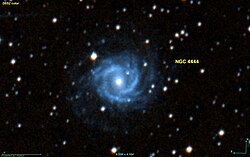| NGC 4444 | |
|---|---|
 DSS image of NGC 4444 | |
| Observation data (J2000 epoch) | |
| Constellation | Centaurus |
| Right ascension | 12h 28m 36.419s [1] |
| Declination | −43° 15′ 42.15″ [1] |
| Redshift | 0.009771 [1] |
| Heliocentric radial velocity | 2915 km/s [1] |
| Distance | (38.8 ± 5.7 Mpc) [2] |
| Characteristics | |
| Type | SAB(rs)bc [3] |
| Mass | 5.8 billion [4] M☉ |
| Apparent size (V) | 2′.4 × 1′.6 [5] |
| Other designations | |
| MCG -07-26-007, PGC 41043 [1] | |
NGC 4444 is an intermediate spiral galaxy in the constellation Centaurus. The morphological classification places it midway on the continuum between a barred spiral (SB) and an unbarred spiral (SA), with an inner region that lies between a ring-like (r) and a purely spiral form (s), and medium- (b) to loosely wound (c) outer spiral arms. This makes it a hybrid ringed, barred spiral galaxy. [6] It has an angular size of 2.4 × 1.6 arcminutes [5] and the estimated mass M is given log M = 9.76, yielding 5.8 billion solar masses. [4]